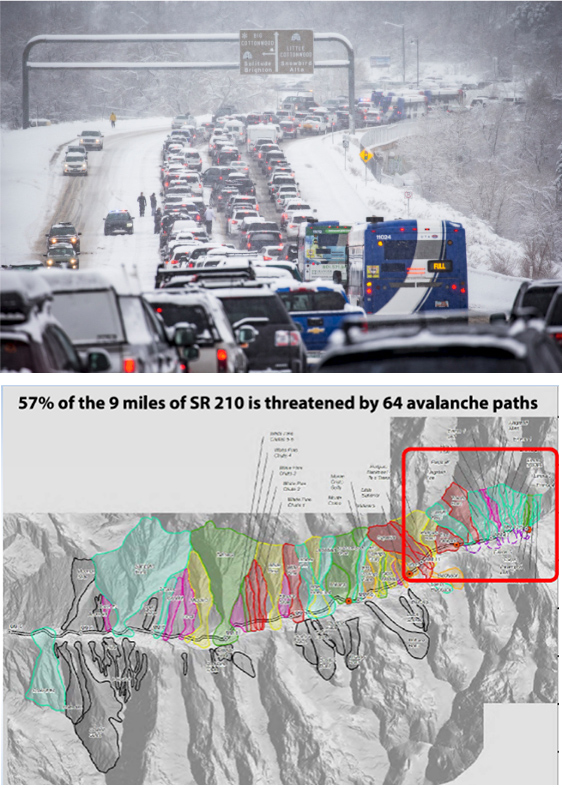
The Utah Department of Transportation (UDOT) has a plan to replace a narrow, winding highway leading to a popular ski area with an 8-mile-long (13 km) electric gondola ride. The move would make the site accessible via public transportation, removing the need to clog the highway with cars, cut down on traffic accidents, and decrease emissions in the canyon.
The planned route for the gondola passes through Little Cottonwood Canyon, where State Route 210 connects Salt Lake City with four major ski resorts in an area with world-class skiing.
The electric gondola has been proposed as a solution to the major traffic concerns along the highway, which has been described as having traffic that “has gotten so bad, particularly on snowy ‘powder’ days, that the canyon becomes more or less undriveable after 8 a.m. if there is any significant snowfall.”
Avalanches and traffic accidents can also lead to miles-long traffic jams along the highway. SR 210 is known as the most avalanche prone highway in North America, as it sits in the way of 64 active avalanche paths.

UDOT proposed three potential solutions: widening the highway as well as increasing bus routes along the road, laying down a rail network next to the highway, or constructing a gondola to fly passengers above the highway. The gondola plan was ultimately chosen as the most effective, and is currently in discussion stages before seeking final approval.
The proposed Little Cottonwood Canyon Gondola Project is a far cry from an oversized ski lift or cable car. UDOT project manager Josh Van Jura explained that the project would use large climate-controlled gondolas that carry up to 35 passengers and feature heated seats with built-in USB charging, offering just as comfortable of a journey as a car ride. The gondolas would arrive every two minutes, resulting in a maximum theoretical throughput of over 1,000 passengers per hour. The highway currently sees around 7,000 vehicles per day.
The proposal includes building the La Caille base station as the starting point for the zero-emission gondola. Located on the edge of Salt Lake City, the multi-modal hub would include several thousand parking spots and feature rental lockers for ski gear, eateries, and shopping.
A 31-minute gondola ride from the La Caille station would whisk passengers through the canyon, flying above the highway towards the Snowbird station. Passengers remaining on would have another six-minute journey on the gondola to reach the final point at the Alta Station.
The estimated cost is said to be between $391 million to more than $1 billion. As a Utah Department of Transportation project, the gondola would be funded by state capital similarly to other transportation or road projects.
The project is currently open for comment from Utah residents until February 26, after which a decision will be made whether or not to move forward with the project.
Electrek’s Take
I think this is an incredible demonstration of how zero-emission alternatives can be an improvement not just for the environment, but also for daily quality of life.
The current situation is awful, with people frequently stuck in hours-long traffic jams or just being unable to use the road at all — which is itself a safety concern when evacuations are necessary. Adding more buses or lanes would add more noise and pollution to the canyon.
I understand that there are objections to the project, largely based on the money it would take to build or the potential “ruining the view” of the canyon. My response to the NIMBYs is that this is why you have taxes, and that the view would be much worse if they build a bigger highway or put hundreds more buses on it. And if you don’t like seeing cables or gondolas on your mountain, then perhaps you would have preferred stairs instead of a chairlift at your local ski resort? Yeah, I didn’t think so. A few thin cables aren’t going to destroy the view, nor are the support towers that are likely to be nicely camouflaged along the way, just like how cell-phone towers are often built to look like trees in many cities.
Admittedly, the 37-minute trip is longer than a car drive, which takes around 20 minutes without traffic. But when the road is impassible due to traffic jams, accidents or inclement weather, 37 minutes sounds a lot better than canceling a trip or spending hours stuck in an idling car halfway up a mountainside. Plus it’s a beautiful, 37-minute scenic trip through the mountains. Sign me up!
